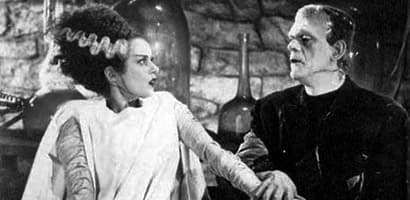Frankenstein
Critique • Text • Frankenstein at the movies
 Frontispiece, first illustrated edition 1831
Frontispiece, first illustrated edition 1831Original title
Frankenstein; or, The Modern Prometheus
First publication
1818
Literary form
Novel
Genre
Literary, science fiction, horror
Writing language
English
Author's country
England
Length
Approx. 78,000 words

The monster (Boris Karloff) takes a wife (Elsa Lanchester)—or tries to anyway.
Fleshing out the family
Bride of Frankenstein (1935): Film, 75 minutes; director James Whale; writers William Hurlbut, John Balderston; featuring Boris Karloff, Colin Clive, Elsa Lanchester
Frankenstein was a huge hit, especially when paired with Dracula on double bills.
So, of course, Universal Pictures proceeded to drive both franchises into the ground with sequels. But the first few out were actually pretty good, benefiting from funding that the first films lacked. They're smoother, if somewhat less intense, productions.
Monster takes a wife
Many consider the first Frankenstein sequel, Bride of Frankenstein (1935), with James Whale repeating as director, to be an even greater film.
Elsa Lanchester plays two roles, firstly Mary Shelley, who in this movie supposedly recaps the plot of her novel Frankenstein to Percy Bysshe Shelley and Lord Byron. What she describes though is actually the plot of the Hollywood film based on it. Then she reveals the monster and doctor did not die at the story's end as thought. She's been planning a sequel, it appears, which she then relates—and the movie follows.
Both protagonists have survived. Another unscrupulous scientist, one Doctor Pretorius, forces Henry Frankenstein to create for the monster a mate, briefly but memorably also portrayed by Lanchester.
This imagined tale actually picks up some of the previously missing elements of Shelley's original novel, such as the monster learning to speak and asking the doctor to make a woman for him.
It is also a more elaborate story than the first Frankenstein movie with obviously more money spent on its sets and actors, and sporting some sophisticated camera work.
At times it does veer into old-fashioned Hollywood melodrama, particularly concerning Dr. Frankenstein and his fiancée (whom we really don't care about).
But Boris Karloff is at his most affecting as the supposed monster and veteran British actor Ernest Thesiger steals several scenes as the sinister Pretorius.
— Eric
Critique • Text • Frankenstein at the movies
1931, 1935, 1939, 1942–1948, 1957, 1958–1970, 1973–1996, 1994, 2014


